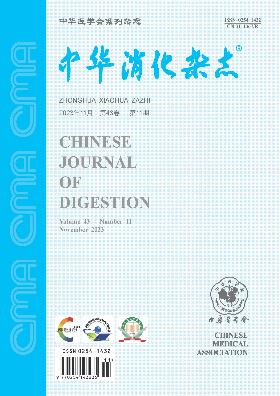Analysis of pathogens and risk factors of severe acute pancreatitis complicated with infection
引用次数: 0
Abstract
Objective To investigate the characteristics of pathogens and risk factors of severe acute pancreatitis (SAP) complicated with infection, so as to provide reference for clinical diagnosis and treatment. Methods From February 2011 to January 2018, at the First Affiliated Hospital of Chongqing Medical University, 438 patients with SAP were selected. The samples including ascites, sputum and blood were collected and cultured. Distribution and drug resistance of pathogens were analyzed. Chi-square test and logistic regression analysis were used for analyzing the risk factors related to SAP complicated with infection. Results The total infection rate of SAP was 49.09% (215/438), of which the bacterial infection rate was 44.29% (194/438) and the fungal infection rate was 22.60% (99/438). A total of 625 pathogens were cultured, including 333 (53.28%) strains of Gram-negative bacteria, 171 (27.36%) strains of Gram-positive bacteria and 121 (19.36%) strains of fungi. Gram-negative bacteria were extremely resistant to β-lactams antibiotics, among them Acinetobacter baumannii was the highest (63.93% to 100.00%), and resistance rate to enzyme inhibitors was slightly lower (11.54% to 48.15%). The resistance rates of Gram-positive bacteria to penicillin and erythromycin were both high, which were 92.86% to 100.00% and 81.25% to 95.00%, respectively, and Gram-positive bacteria resistant to vancomycin, linezolid, and tigecycline were not found. The resistance rate of fungi was generally low (0 to 28.57%). The results of logistic regression analysis showed that multiple organ dysfunction syndrome (MODS) (odds ratio (OR)=2.031, 95% confidence interval (CI)1.230 to 3.356), acute physiology and chronic health evaluation Ⅱ(APACHE Ⅱ) score≥11 (OR=1.780, 95%CI 1.129 to 2.806), fasting time more than three weeks (OR=3.437, 95%CI 2.119 to 5.574), mechanical ventilation (OR=2.697, 95%CI 1.643 to 4.427) and surgery (OR=3.464, 95%CI 1.806 to 6.643) were the independent risk factors of SAP complicated with infection (all P<0.05). The results of stratified analysis indicated that MODS, fasting time more than three weeks, mechanical ventilation and surgery were the independent risk factors of more locus infection (all P<0.05). Conclusions The infection rate of SAP is high and the risk factors are complex. Early prevention, improvement of the pathogen detection and guiding the reasonable use of antibiotics are necessary. For patients with invasive procedures and treatment, aseptic awareness should be strengthen to prevent iatrogenic infection. Key words: Infection; Drug resistance; Risk factors; Severe acute pancreatitis重症急性胰腺炎并发感染病原菌及危险因素分析
目的探讨重症急性胰腺炎(SAP)并发感染的病原菌特点及危险因素,为临床诊断和治疗提供参考。方法选取2011年2月至2018年1月重庆医科大学第一附属医院的438例SAP患者。收集腹水、痰、血等标本进行培养。分析病原菌分布及耐药情况。采用卡方检验和logistic回归分析SAP合并感染的相关危险因素。结果SAP总感染率为49.09%(215/438),其中细菌感染率为44.29%(194/438),真菌感染率为22.60%(99/438)。共培养病原菌625株,其中革兰氏阴性菌333株(53.28%),革兰氏阳性菌171株(27.36%),真菌121株(19.36%)。革兰氏阴性菌对β-内酰胺类抗生素的耐药率极高,其中鲍曼不动杆菌最高(63.93% ~ 100.00%),对酶抑制剂的耐药率略低(11.54% ~ 48.15%)。革兰氏阳性菌对青霉素和红霉素的耐药率均较高,分别为92.86% ~ 100.00%和81.25% ~ 95.00%,未发现革兰氏阳性菌对万古霉素、利奈唑胺和替加环素耐药。真菌的耐药率普遍较低(0 ~ 28.57%)。logistic回归分析结果显示,多器官功能障碍综合征(MODS)(优势比(OR)=2.031, 95%可信区间(CI)1.230 ~ 3.356)、急性生理和慢性健康评估Ⅱ(APACHEⅡ)评分≥11 (OR=1.780, 95%CI 1.129 ~ 2.806)、禁食时间大于3周(OR=3.437, 95%CI 2.119 ~ 5.574)、机械通气(OR=2.697, 95%CI 1.643 ~ 4.427)、手术(OR=3.464,95%CI 1.806 ~ 6.643)是SAP合并感染的独立危险因素(P<0.05)。分层分析结果显示,MODS、禁食时间大于3周、机械通气和手术是多位点感染的独立危险因素(P<0.05)。结论SAP感染率高,危险因素复杂。早期预防,提高病原菌检测水平,指导合理使用抗生素是必要的。对于有创手术和治疗的患者,应加强无菌意识,防止医源性感染。关键词:感染;耐药;风险因素;严重急性胰腺炎
本文章由计算机程序翻译,如有差异,请以英文原文为准。
求助全文
约1分钟内获得全文
求助全文

 求助内容:
求助内容: 应助结果提醒方式:
应助结果提醒方式:


